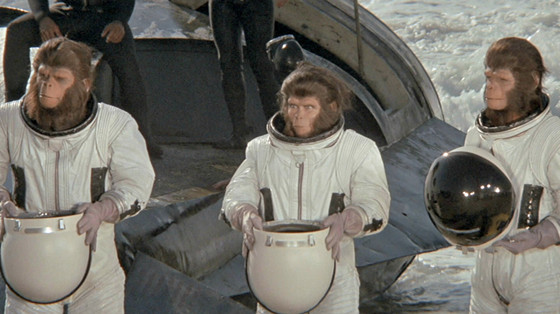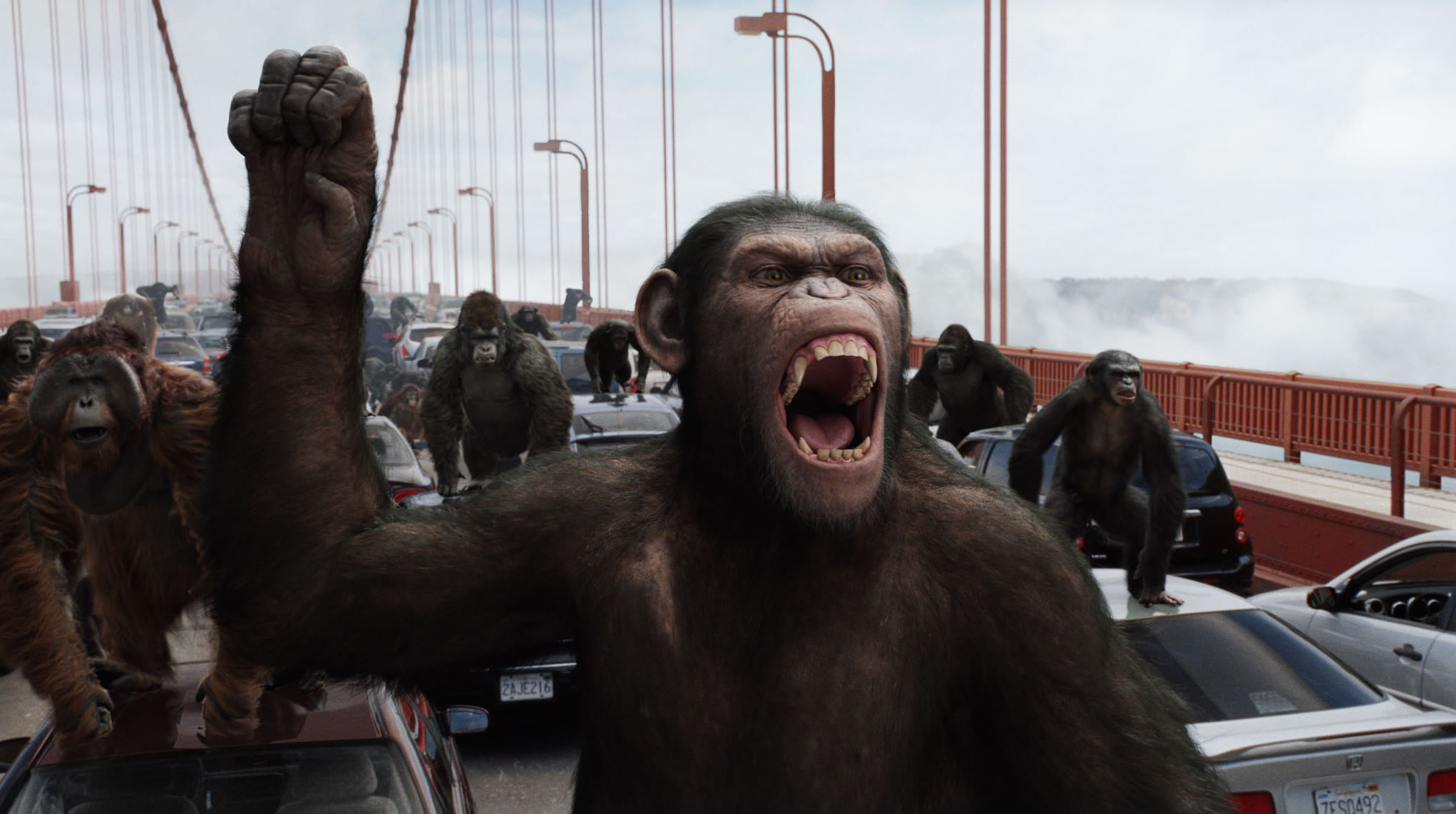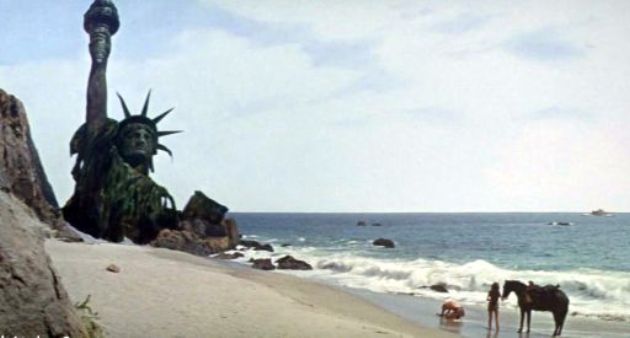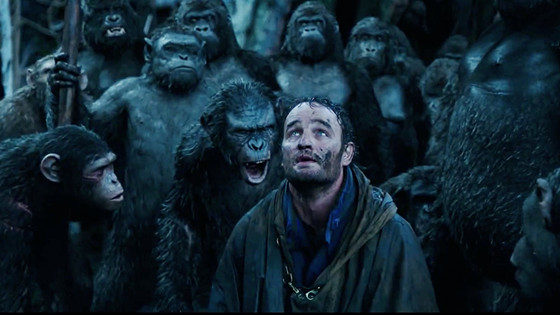5. Escape from the Planet of the Apes

After Beneath the Planet of the Apes definitive ending, the next chapter in the series took the story in a completely different direction. The plot is moved to contemporary United States which also helped with budget cuts as they no longer needed to spend money on sets or on as much ape make-up effects. The underlying themes also focused more on racial conflicts which was a big present day issue.
Two simian apes Zira and Cornelius flee their doomed planet on a spacecraft left by an American space traveller. They travel through a wormhole which sends them back in time to the 20th century. Immediately they are treated like celebrities, lavished with gifts and given media attention. Until they receive the attention of a scientist who believes they could be a threat to the entire human race.
The fresh approach and ideas gave the series a new life after its predecessor Beneath the Planet of the Apes received poor reviews from critics and drained energy from the series. Escape would go on to become the best received sequel from critics. The film was almost handled like a modern day reboot and the team could now go on to tell the story of how these highly intelligent apes would go on to one day rule the earth.
Ruddy McDowell and Kim Hunter as Cornelius and Zira were supporting actors in previous films but now take centre stage as the lead actors. They are the main driving force which makes the film so compelling especially with their likeability and the characters role reversal.
In the original film it was the human character Taylor who was imprisoned and tested on by Apes who didn’t understand him. But in Escape from the Planet of the Apes the apes are now locked up, although this time it’s not just down to ignorance, it’s also down to fear.
Escape from the Planet of the Apes was released in 1971, the same time that racial segregation was ending across America. The story, not so subtly, addresses racism and not living in fear of people just because they happen to look differently from yourself. One of the main subplots focuses on the ideas and themes of future and destiny being tackled by the concept of trying to change the current timeline, even if you have to commit a horrible act to do it.
There are some plot-holes and inconsistencies from previous films that don’t quite add up. But if you suspend your disbelief, especially for the introduction, then the film is highly enjoyable fun with great performances all round.
4. Rise of the Planet of the Apes

When Rise of the Planet of the Apes was released in 2011 no one was expecting the film to be such a critical and box-office success. The first reboot directed by Tim Burton had left a sour taste in viewer’s mouths, fortunately ‘Rise’ rejuvenated the franchise and kick started a new series of films.
Will Rodman is a scientist working for a pharmaceutical company trying to find a cure for Alzheimer’s. A new drug has been tested on chimpanzees to positive results, that is until it drives one chimp crazy and they try to attack humans in a rage. Will later realises the chimpanzee was pregnant and was only trying to protect her new-born.
Rather than putting down the baby chimp, he takes it home to live with himself and his father. They slowly realise that the chimpanzee, now named Caesar, is highly intelligent. The authorities eventually imprison Caesar in an ape sanctuary but after the apes are mistreated again by humans, they start to revolt.
Until this point, there had never been a visually better Planet of the Apes film. Aesthetically, Tim Burton’s film did look great. But the difference in technology between his film and Rise was enormous. The motion capture technology is superb in creating life-like apes on screen from the motions and movements to their facial expressions. Andy Serkis does a tremendous job in his motion capture role playing Caesar, so much so that people campaigned to get him an Oscar nomination for Best Supporting Actor.
The depth of the characters is handled expertly. Although the humans almost take a back seat to the apes, James Franco’s character Will Rodman is extremely likeable and clear in his motivations.
There are highly touching moments between him and his father and the relationship between Will and his partner, played by Freida Pinto, is fun even if not fully developed. The main driving force is his relationship and love for Caesar who is not only his best friend but he is also treated as a real member of the family.
Director Rupert Wyatt is a huge fan of the original Planet of the Apes series. He stays respectful to the classic while planting many references and Easter-eggs throughout but without ever crossing the line to poking fun at the original.
Many of the apes and human characteristics were flipped such as Caesar’s mother being named “Bright Eyes” which was Charlton Heston’s name in the 1968 original. There are many more fun hidden tributes throughout such as more character names to spot, to inspired visual imagery, even to references to the space shuttle from the original film which also helps cement Rise of the Planet of the Apes as a true prequel.
3. War for the Planet of the Apes (2017)

It is very rare that a modern film trilogy doesn’t have a bad entry in the series but it is even rarer that every film in the series is brilliant in its own right. Any fears of the last part of the trilogy being a let down were quickly squashed as the critics gave high praise to the summer’s best intellectual blockbuster.
In War for the Planet of the Apes, we rejoin Caesar and his apes as they are forced into a deadly conflict with an army of humans led by a merciless Colonel. After the ape family suffer unthinkable losses, Caesar struggles with his darker instincts and his ideas for vengeance against humankind. As the ape’s epic journey brings Caesar and the Colonel face to face, they are drawn into a monumental battle that will determine the fate of the planet.
Not a single frame is wasted by director Matt Reeves. The film is full of stunning cinematography from start to finish; with dazzling sets and locations which transport you deep into the middle of the ape’s world. War for the Planet of the Apes has probably the best use of CGI and motion capture ever committed to film. Caesar’s character has been rapidly developing throughout the series and now in the close ups, you can clearly see Andy Serkis in there more than ever before. All of his facial expressions are realised and you feel exactly how he is feeling. Caesar has become mythical himself and will go down as one of the most compelling characters in modern cinema.
The stunning musical score by Michael Giacchino is completely wonderful. It heightens the experience, enhances moments of silence, captures the tension and suspense and overall suits the material to a T. Giacchino is quickly cementing himself as one of the all time great film score composers.
Like the other previous entries, there are many Easter-eggs and links to the series. But this time the links are much more accessible to casual fans. The script expertly sets up the state of the humans in the original 1968 film while also setting up one of the original characters in a charming way.
There is much-needed humour injected into the film with the addition of the new character Bad Ape. Throughout the film’s sombre tone and dark setting, he provides some uplift. While being a hilarious and endearing character, he also surprisingly gives some of the most touching moments.
War for the Planet of the Apes is a stunning conclusion to Caesar’s story but also an incredible film in its own right. It’s the completion of a masterful trilogy which works extremely well as a whole story linking together. The Apes prequel series can now be added to the list of the greatest film trilogies of all time after pulling off the near impossible of not featuring one bad film.
2. Planet of the Apes (1968)

The original Planet of the Apes was based on a French novel called La Planete des Singes by Pierre Boulle (The Bridge over the River Kwai). It was producer Arthur P. Jacobs pet project, who fought for years to get the film made. Arthur would then go on to produce all 5 films from the original series.
The creator of The Twilight Zone was brought on as a scriptwriter and changed many elements from the book, including adding the iconic twist ending. Charlton Heston was convinced to star in the film and Franklin J. Schaffner took on the job of director. After recording a screen test, Fox decided to take the risk and finance the film. The gamble ultimately paid off. Their $5.8 million budget went on to make more than $33 million at the box office and the film received widespread critical acclaim.
3 astronauts wake up from a deep hibernation to discover that their ship has crash landed on an unknown planet and it is now the year 3978 AD which is over 2000 years from their departure date. The astronauts begin to explore the planet to conduct some soil tests when they stumble across a group of primitive humans that can’t speak. They soon realise that the planet is ran by highly intelligent apes who treat humans like animals. After they are captured and tested on, Taylor befriends a couple of compassionate apes while he plans his escape from the prison.
Planet of the Apes came along surprising the audience as there had really been nothing like it before. The make up and costumes were handled extremely well and it went on to receive an honorary Oscar for Outstanding Make-up Achievement and was nominated for Best Costume Design. The design of the apes is so iconic that they still kept a similar look over 30 years later in the Tim Burton remake in 2001.
Although the recent reboot would go on to focus more on the ape characters with the humans taking a back seat, the original mainly focused on Charlton Heston’s character Taylor. The two apes he befriends Zira and Cornelius, played by Kim Hunter and Roddy McDowall respectively, deliver great performances and become fan favourites which resulted in them being the focal point of future films.
The ending to Planet of the Apes would go down as one of the greatest movie twists of all time. It has been copied and parodied numerous times. But for its time it was one of the most shocking endings audiences had eber witnessed, especially with the public’s ongoing fears of a nuclear bomb attack.
1. Dawn of the Planet of the Apes

Dawn of the Planet of the Apes is the pinnacle of the Planet of the Apes series. It contains all of the best elements from each film from the political undertones to the stunning special effects to outstanding action set pieces to strong likeable characters and a thrilling plot with Shakespearean ambitions.
Ten years after the events of Rise of the Planet of the Apes a deadly virus has ravaged human civilization wiping out large parts of humanity. The evolved apes are now living in woods in San Francisco, led by Caesar, who now has his own son Blue Eyes. There is hostility after they stumble across a group of humans on their land but it’s revealed that the humans don’t want trouble, they are only looking to repair a hydroelectric dam to restore power to their city for the survivors. Caesar let’s them work on repairing the dam but his lieutenant Koba doesn’t trust humans and wants a war against mankind.
There was scepticism towards this sequel as the director Rupert Wyatt had left the project and main actor James Franco wouldn’t be returning. “Cloverfield” director Matt Reeves was hired to take over the film. Although the director had changed, the sequel was similar in tone and style while also successful building on the lore and character development from the original.
The characters of Caesar and Koba, and their relationship, is dead-centre in this story. Caesar’s character is more full and developed as he becomes more intelligent and interesting. The side story with his partner and son also gives him more depth and relatability. Koba’s character actually goes through the largest character arc. From having a small role in Rise, the seeds were planted when you see him being tested on and tortured by humans. But in Dawn he becomes more vengeful towards mankind and actually has a highly emotional scene pointing out his facial scars to Caesar and declaring it was “Human work!”.
The visuals and special effects are both striking with Matt Reeves having a great eye for impactful imagery. The fortress the apes live in is a sight to behold and looks like something out of a Kurosawa film. The motion capture special effects have also been improved with the apes looking more realistic than ever, the scenes with the apes interacting with each other are seamless. The special effects are arguably some of the best use of CGI ever created.
Dawn of the Planet of the Apes was proof that audiences still liked intelligent blockbusters. Beating the box-office of its predecessor while also receiving more favourable reviews from film critics. With a thoughtful story, full of extremely powerful moments and backed by great characters, Dawn of the Planet of the Apes eclipsed the idea of a ‘Summer-Blockbuster’.
Author Bio: Craig Nixon is an Asian film critic from Glasgow, Scotland. He is also a fan of the films ‘Cannibal Holocaust’ to ‘Mean Girls’ and everything in between. Follow his Asian Cinema blog www.temptasianfilm.blogspot.co.uk.